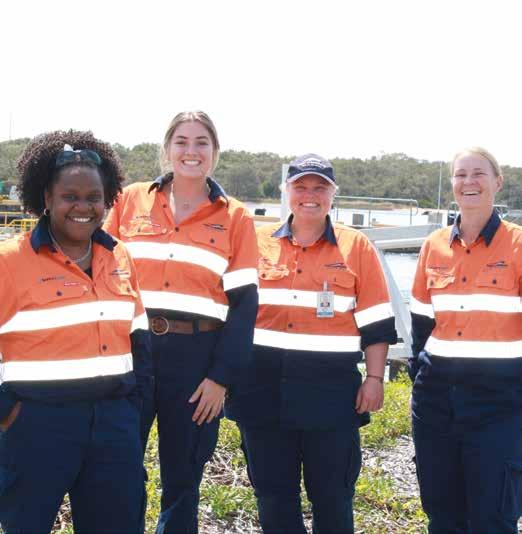
3 minute read
Breaking down barriers at the Port of Brisbane
By Simon Enticknap
A pioneering program introduced at the Port of Brisbane is creating new opportunities for women to forge a career in the maritime industry.
Advertisement
Like many workplaces in the maritime sector, the workforce at the Port of Brisbane has traditionally been heavily skewed towards male participants.
The Port of Brisbane has recognised the importance of creating a more diverse workforce, to better understand and meet the needs of today’s customers and stakeholders. Seeking to achieve this goal and overcome gender barriers to entry, last year they launched a new cadetship program aimed at encouraging more women to join the workforce.

Port of Brisbane from above
Image supplied by Port of Brisbane
The first of its kind in Australia, the cadetship offers a 24-month paid employment and training program for women working as deckhands in the Port of Brisbane Marine Operations team.
‘With just six women from hundreds of men applying for a marine role in the last decade, we made a decision to disrupt traditional recruitment methods to accelerate a change in our workforce gender profile,’ explained Port of Brisbane Chief Operating Officer Peter Keyte.
‘We wanted to challenge misconceptions about the opportunities available within our industry, the nature of the work and the skills and perspectives required.’
‘This process of change has involved addressing known impediments to employment that often deter more women from considering a career in the industry.’
‘We’ve changed the way we advertise vacant positions and promote our business as an employer of choice for women—including the images we use in our advertisements, and where we advertise roles. We also share the career journeys of women in our business to raise awareness of the fact that women can enjoy a rewarding career in maritime.’

First intake of cadets
Image supplied by Port of Brisbane
Following the inaugural open day for the cadetship program in June last year, four women were selected for the first intake out of 150 applications received from across Queensland, interstate and even overseas.
No specific industry skills are required from prospective candidates, but they are expected to enjoy working outdoors as part of a small team, be interested in learning new skills, and show a commitment to putting in the extra time and effort needed to gain qualifications and complete their training.
A key aspect of the program is creating the right environment in which women can feel supported in their role as they develop practical skills and gain experience.
Make no mistake, this is a hands-on role and the women are expected to perform all the necessary deckhand duties including maintenance, safety management and cleaning while learning about the port’s operations.
‘During the two-year cadetship, the cadets are trained and mentored in all aspects of the port’s operations, including learning first-hand from experts in the field. They acquire hands-on experience in dredging, berth-levelling, maintenance and vessel inspections, as well as learning how to operate a class C6 crane,’ Peter said.
‘The cadets also take part in the company’s mentorship program which is designed to support the growth, development and inclusion of people new to the industry.’
By the end of the program, cadets are expected to gain a master under 24 metre (near coastal) and marine engine driver grade 3 qualifications.’
Although there is no guarantee of a future role at Port of Brisbane at the end of the cadetship, the qualifications and job experience they gain during the cadetship will lay the groundwork for a career in the industry, and the opportunity to apply for any positions that become available.
Initiatives like the Port of Brisbane cadetship program are in line with the objectives of the International Maritime Organization (IMO), which has made ’Empowering Women in the Maritime Community‘ the theme of this year’s World Maritime Day.
This focus on addressing gender imbalance reflects the changing nature of the maritime industry and, according to the IMO, helps to drive growth and development while delivering benefits for everyone engaged in the maritime sector.
Looking further ahead, Port of Brisbane says it will review cadet requirements prior to the next intake to determine what positions are available.
The Port of Brisbane is one of the fastest growing container ports in Australia and an important gateway for global trade in Queensland. Each year, more than 2700 vessels are berthed at the port, accounting for over 33 million tonnes in trade valued at more than $50 billion.
In addition to the busy container and cargo terminals at the port, the Port of Brisbane is also building the nearby Brisbane International Cruise Terminal which, when completed, will be the only dedicated terminal facility in south–east Queensland capable of hosting mega cruise ships.
With growth and opportunity at the port a given, the message from the current group of cadets to other women thinking about embarking on a career in the maritime industry is ’just do it!’
Website: portbris.com.au
Facebook: @PortBrisPtyLtd
Twitter: @port_brisbane
Instagram: @portofbrisbane










